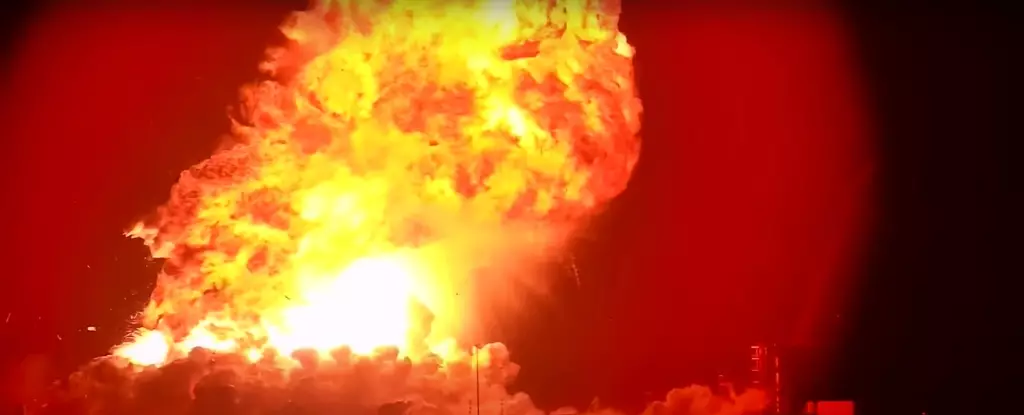In the scramble for interplanetary domination, an explosion during a routine static fire test at SpaceX’s Starbase facility in Texas serves as a glaring reminder of the challenges that even the most ambitious engineering marvels face. As a fiery plume erupted over the launch site at approximately 11 PM, it’s difficult to ignore the somewhat casual approach displayed by CEO Elon Musk in the aftermath. Far from the jubilant promises of humanity’s descent onto Mars, this event throws into stark relief the precarious nature of the current space race, wherein unfathomable advancements can be set back by avoidable miscalculations.
SpaceX’s initial statement downplayed the serious consequences of the mishap: “Just a scratch,” Musk proclaimed on social media, as though such an explosive event is merely a minor hurdle in a grand adventure. This casual dismissal of an incident that obliterated significant components of the Starship raises concerns about the culture of risk acceptance at SpaceX. Such bravado may embolden Musk’s loyal supporters, but it neglects the very real and tangible risks associated with space exploration and development.
The Pressurized Dilemma: Are Risks Being Underestimated?
Initial investigations hinted at a potential failure of a composite overwrapped pressure vessel (COPV) within the rocket, fundamentally questioning the structural integrity of such critical components. If the analysis finds systemic issues rather than isolated incidents, this could spell trouble for SpaceX’s ambitious plans, which rely on a flawless execution of safety protocols during both testing and future launches.
It’s imperative to understand that these are not just engineering mishaps; they are cautionary tales. The reliance on a “fail fast, learn fast” model may overlook significant risks if pressing questions about safety remain unaddressed. The interplay between innovation and safety is delicate and shouldn’t be treated with levity, especially when human lives may be on the line during eventual crewed missions to Mars.
The Bigger Picture: Sustainability Over Recklessness?
NASA’s increasing dependence on SpaceX for crucial missions reflects a mixture of hope and anxiety. Herein lies a significant paradox: SpaceX is touted for its rapid prototyping and launch capabilities, yet the pace of these developments should not come at the expense of long-term safety and environmental considerations. While the Federal Aviation Administration greenlit an increase in Starship launches, conservationists and environmental advocates remain wary. Can we truly reconcile the goal of expanding human presence in outer space with the need to protect Earth’s vulnerable ecosystems?
The capacity to conduct 25 Starship launches annually symbolizes an aggressive expansion strategy, noteworthy in its ambition but questionable in its environmental stewardship. Setbacks like the recent explosion and the earlier detonations in May and beyond should encourage both SpaceX and authorities to reassess whether such rapid scaling is achievable without considerable consequences.
Beyond the Flame: How Much Longer Can the Optimism Last?
Elon Musk’s visions of colonizing Mars may be breathtakingly optimistic, but they also raise essential questions about feasibility and the integrity of those visions. The cycle of pushing boundaries, facing setbacks, and confidently reassuring the public may work momentarily. Yet, how sustainable is this model? Each explosion reveals more than just technical flaws; it’s a signal of the daunting challenges ahead in real-time developments.
The ambition of building a new world on Mars is undeniably alluring, yet we must demand transparency and accountability from SpaceX and similar outfits. The risks being taken are not merely theoretical; they carry the weight of history, echoing past failures in the pursuit of unprecedented achievements. As society stands at the cusp of interplanetary exploration, we owe it to ourselves and the potential future inhabitants of Mars to ensure that our resolve to colonize is underpinned by rigorous safety standards and environmental ethics.
It is time for SpaceX and its leadership to lean into the complex interplay of technological advancement and responsibility, ensuring that humanity’s quest for the stars does not lead us to cripple our prospects on Earth.

